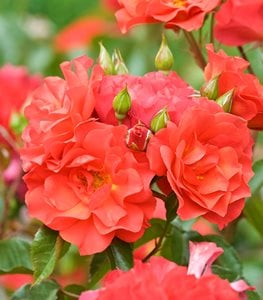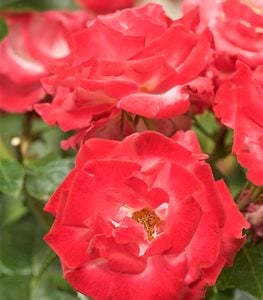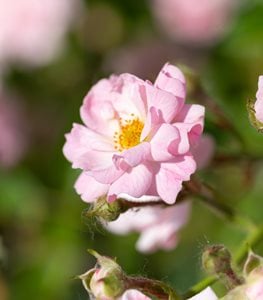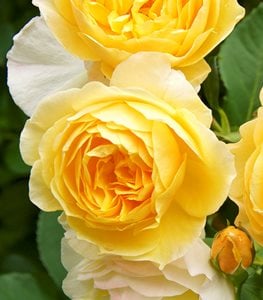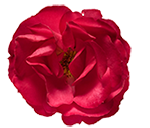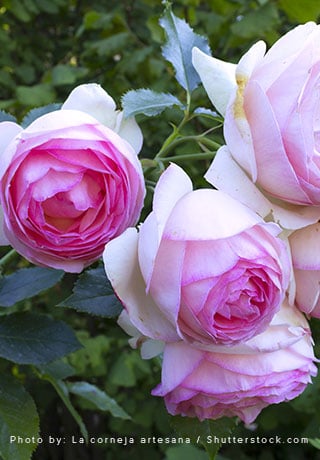The Best Types of Roses for Your Garden
A guide to choosing the right kind of rose for your landscapeOne of the most beloved garden plants in the world, roses have been around for thousands of years. Rosaceae, the rose family, includes 150 species and thousands of cultivars.
Grown for their showy blooms and romantic fragrance, roses come in a dizzying array of forms, sizes, and types. Sorting them out can be confusing, even for experienced gardeners. Here’s a basic primer of the most commonly grown types and how to use them in the landscape.
On this page: Rose Types | Rose Groups | Tips for Choosing the Best Roses
On this page:
ROSE TYPES
FLORIBUNDA
First developed around 1940, these hybrids combine the free-flowering nature and compact habit of polyanthas with the vibrance and color range of hybrid teas. Flowers are smaller than hybrid teas, but are borne in profuse clusters on bushy plants, creating a striking effect in the landscape. These are suitable in mixed cottage-style borders, massed along a slope for erosion control, as privacy hedging, or in containers. The easy-care nature and hardiness makes these a good choice for beginning gardeners.
Zones: 4-10
Height/Spread: Compact bushy habit, 2-5 feet tall and 2-4 feet wide
Bloom time: Repeat or continuous bloom from early summer to fall
Color: Flowers are white, yellow, pink, gold, lavender-blue, burgundy, apricot, orange, red or bicolored
Try: ‘Cinco de Mayo’ (pictured), ‘Iceberg’, ‘Bonica’, ‘Amber Queen’, ‘Sunsprite’, and ‘Julia Child’
HYBRID TEA
Hybrid teas, which are a cross between tea roses and hybrid perpetuals, became the first modern rose type when introduced in 1867. The wide range of flower colors and large fragrant blooms, which are each borne on a long single stem, make these a favorite of seasoned gardeners, exhibitors, and florists. Hybrid teas can be higher maintenance and more susceptible to pests and diseases than other types. Plant in a mixed border, mass planting, container, or as a stand-alone accent.
Zones: 5-9
Height/Spread: Upright bushy habit, 3-8 feet tall and 2-3 feet wide
Bloom time: Repeat or continuous bloom from late spring to fall
Color: Flowers are white, yellow, pink, gold, lavender-blue, burgundy, apricot, orange, red, bi- or multi-colored
Try: ‘Double Delight’ (pictured), ‘Peace’, ‘Mister Lincoln’, ‘Fragrant Cloud’, and ‘Just Joey’.
GRANDIFLORA
These taller shrub types, which were introduced in the 1950s, are a cross between hybrid teas and floribundas. They are characterized by clusters of 5-7 large, showy blooms on robust stems. Use in a mixed border, as hedging, or as a striking focal point in the landscape. Makes an excellent cut flower.
Zones: 5-9
Height/Spread: Upright bushy habit, 3-8 feet tall and 2-5 feet wide
Bloom time: Repeat bloom from late spring to fall
Color: Flowers are purple, red, orange, white, pink, or yellow
Try: ‘Dick Clark’ (pictured), ‘Gold Medal’, ‘Tournament of Roses’, ‘Mother of Pearl’, 'Octoberfest’, and ‘Cherry Parfait’.
POLYANTHA
Developed in the late 19th century, these exceptionally tough roses are similar in stature to floribundas, though smaller, with a dense growth habit and clusters of 1- to 2-inch blooms that are rarely fragrant. Though most are shrubs, some are climbers. Use as edging along a pathway, at the front of a mixed border, as hedging, or in containers. Virtually carefree and disease-free.
Zones: 4-10
Height/Spread: Compact, spreading or climbing habit. Shrub forms grow 2-4 feet tall and wide. Climbers such as ‘Cecile Brunner’ can reach up to 10 feet tall and 3-6 feet wide.
Bloom time: Repeat bloom from early summer to fall
Color: Flowers are white, pink, red, apricot, lavender, or crimson
Try: ‘The Fairy’ (pictured), ‘China Doll’ ‘Marie Pavie’, ‘Cecile Brunner’, ‘Perle d’Or’.
SHRUB
Shrub roses are an easy-care alternative to more fussy hybrid teas. This diverse group includes hybrid musk, Kordesii, and English roses. The informal sprawling habit makes these a good choice for larger landscapes, mixed borders, mass plantings and slopes. Learn more about growing shrub roses.
Zones: 3-11
Height/Spread: Mounding, bushy, spreading or groundcover habit, 1-20 feet tall and 1-15 feet wide
Bloom time: Bloom time varies according to variety. These include one-time bloomers from late spring to early summer, as well as repeat and continuous bloomers that flower from late spring to frost.
Color: Flowers in nearly every color except green, blue, or black; green, blue, or purple-tinged foliage.
Try: Oso Easy® series (Oso Easy Peasy®, pictured), Knockout®, Flower Carpet®, ‘Hansa’, ‘Carefree Delight’, ‘Buff Beauty’, and ‘Distant Drums’.
CLIMBERS
These are the romantic vining types that are seen growing up pergolas and arbors and trained along fences. Unlike true vines, they don’t climb on their own and need careful training and sturdy support. These include Noisette and climbing forms of hybrid tea, Bourbon, floribunda, grandiflora, and tea roses. Climbers are best used as screening and to provide vertical interest in the landscape.
Zones: 2-10
Height/Spread: Climbing spreading habit, 6-12 feet tall (or long) and 3-4 feet wide
Bloom time: Late spring to frost
Color: Flowers are pink, white, yellow red, orange, lavender, purple, burgundy and apricot; green foliage
Try: ‘Eden’ (pictured), ‘Cl. Iceberg’, ‘Fourth of July’, ‘William Baffin’, ‘Zephirine Droughin’.
MINIATURE
Bred for their compact size and diminutive one-inch blooms, the name is somewhat deceiving, as some varieties can grow as large as floribundas. Profuse flower clusters occur on sturdy plants in shrub or climbing forms. Suitable for small spaces, raised beds, rock gardens, as pathway edging, and as a stand-alone accent in a container.
Zones: 4-11
Height/Spread: Compact, upright, spreading or climbing habit. Shrub forms grow to 1-3 feet tall and 2 feet wide. Climbers can reach 3-6 feet tall.
Bloom time: Late spring to fall
Color: Flowers are white, pink, red, burgundy, yellow, orange, and lavender; green foliage.
Try: ‘Rainbow’s End’ (pictured), ‘Lavender Delight’, ‘Tiddly Winks’, ‘Hot Tamale’, ‘Gourmet Popcorn’, and ‘Angel Wings’.
ENGLISH (DAVID AUSTIN)
Though not officially recognized as a separate class, English roses are among the most popular with home gardeners. These hybrid shrubs or climbers combine the full-petaled flower form and intense fragrance of old roses with the wider color range, repeat bloom and disease-resistance of modern roses. Also known as David Austin roses for the breeder who introduced them in the 1960s, these do best in milder regions with cooler summers. Use in a mixed border, containers, as hedging, or a stand-alone focal point. Makes an excellent cut flower.
Zones: 4-11
Height/Spread: Upright, bushy or climbing habit, 4-12 feet tall and 3-5 feet wide
Bloom time: Repeat or continuous bloom from late spring until fall
Color: Flowers are white, pink, apricot, yellow, red, coral, burgundy, orange; foliage is green or blue-green.
Try: ‘Graham Thomas’ (pictured), ‘Abraham Darby’, ‘Heritage’, ‘Mary Rose’, ‘Lady of Shalott’, and ‘Gertrude Jekyll’.
More rose types:
- Rambling rose: Larger than climbing roses, growing up to 20 feet high and 15 feet wide, ramblers have flexible stems and are easy to train. Starting in late spring to early summer, ramblers produce massive amounts of flowers in their single, but long-lasting, bloom.
- Patio rose: A compact form, combining miniature and floribunda characteristics, suitable for growing in containers or small spaces. These can include hybrid tea, floribunda, or grandiflora types.
- Landscape rose: Sometimes referred to as groundcover rose, this is a catch-all phrase that includes old and new shrub roses that are virtually maintenance-free.
- Tree rose: Also known as standards, this refers to any type of rose (usually hybrid tea or floribunda) that is trained into a tree form through grafting.
ROSE GROUPS
Rose types overlap because of breeding, so there’s no one definitive way that they are classified. There are three generally recognized groups.
Species roses, sometimes referred to as wild roses, have been growing naturally in the wild for thousands of years and are the ancestors of all roses we see today. These single-flowered types come in shrub or climbing forms and include Rosa arkansana, R. virginiana, R. banksiae, R. glauca, and R. woodsii.
Old garden roses, sometimes referred to as antique, are species and cultivars that existed before 1867, which was the year when the first hybrid tea rose ‘La France’ was introduced. This is recognized as the transition year between old and modern roses. Old roses include Bourbon, Damask, Gallica, Tea, China, and Rambler. These are virtually carefree and easy to grow.
Modern roses are those bred after 1867, comprising most garden roses grown today. These include hybrid tea, polyantha, floribunda, grandiflora, shrub, climbers, and miniature roses.
TIPS FOR CHOOSING THE BEST ROSES
With the myriad varieties of roses available via garden centers and online retailers, it’s hard to avoid making impulse purchases. If you start with a plan and know your limitations, you are less likely to suffer buyer’s remorse. Here are some tips for making wise selections.
- Do your research. Local nurseries will generally carry roses that do well in your growing zone. However, if you are ordering bare-root roses online, be sure to research the recommended growing conditions, soil preparation requirements, and planting instructions.
- Make a plan. Decide on the ultimate use for your roses. Will they be used as focal points in the garden, in mass plantings, as border shrubs, or as climbing plants to adorn an arbor or fence? Once you determine the purpose, you can choose the right variety of rose for your space.
- Grow what you like. Make sure any rose you buy meets your list of criteria in terms of color, fragrance, size, care requirements, and other important traits. Adhering to these parameters will also help you narrow down your options.
- Read the plant tag. Roses are graded according to their quality, which should be noted on the tag, with Grade 1 being the best. Also look for the All-American Rose Selection (AARS) designation for plants that have been tested and judged to be superior in disease resistance, flower production, color, and fragrance.
- Order by mail. If your local nursery doesn’t offer the rose varieties that suit your fancy, browse various online nurseries. There are many reputable retailers that specialize in high-quality roses.
RELATED:
How to Fertilize Roses
Pruning Roses: 8 Steps for Healthy Rose Bushes
Rose Care: A Beginner’s Guide to Growing Roses
20 Fragrant Flowering Plants


